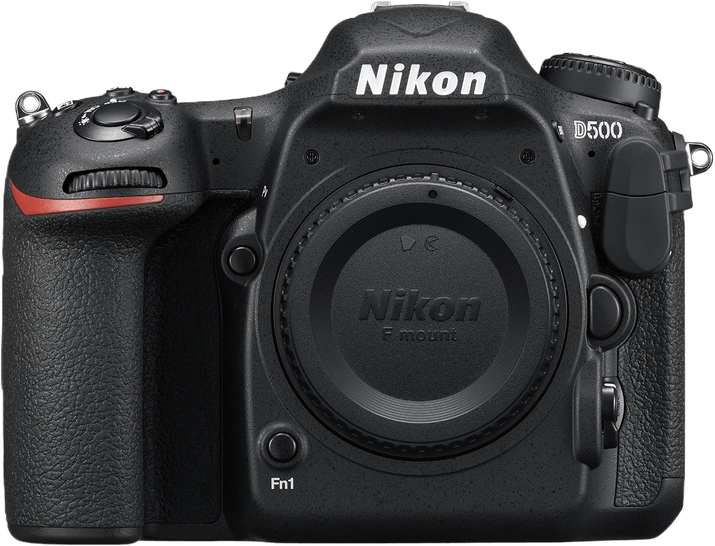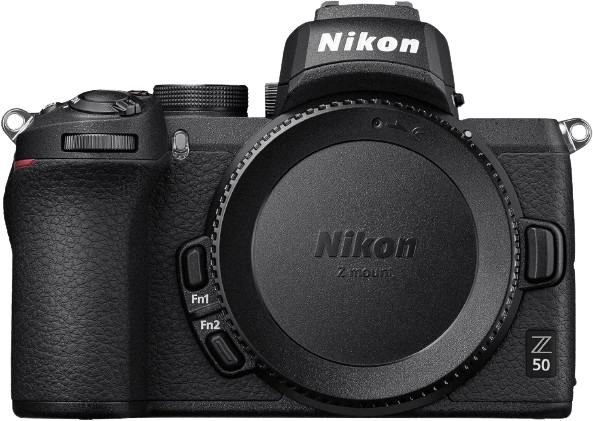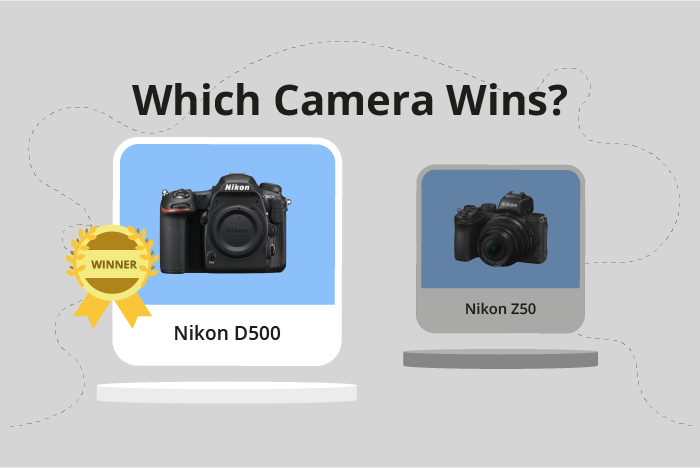Nikon D500 vs Z50 Comparison
Nikon D500

Nikon Z50

The Nikon D500 edges out the Nikon Z50 by a slim margin, scoring 75/100 compared to the Z50’s 73/100. Both cameras share similarities such as being released in the 2010s and having the same manufacturer. The D500, a DSLR camera released in 2016, is larger and heavier, measuring 147 x 115 x 81mm and weighing 1.90lbs. Its higher score indicates its superior performance and features, justifying its $2000 launch price.
On the other hand, the Z50 is a more compact and lightweight mirrorless camera, measuring 127 x 94 x 60mm and weighing just 0.99lbs. Released in 2019, it offers a more affordable option at $859. The Z50’s lower score doesn’t mean it’s a bad camera, but rather it doesn’t match up to the D500’s capabilities.
When considering these cameras, the Nikon D500 is the better choice for those seeking top performance and features, while the Nikon Z50 is a more budget-friendly and compact alternative.
Nikon D500 vs Z50 Overview and Optics
The Nikon Z50 surpasses the Nikon D500 in optics, scoring 72/100 compared to the D500’s 69/100. Both cameras share several specifications, such as 20.9 and 21 megapixels, CMOS sensor type, APS-C sensor size, and no image stabilisation. However, the Z50 outperforms the D500 in certain areas, while the D500 has its own advantages.
The Z50’s edge comes from its Expeed 6 processor, which is more advanced than the D500’s Expeed 5 processor. This results in a faster shooting speed of 11 for the Z50, compared to the D500’s 10. Additionally, the Z50 has a higher DXOMARK score for the sensor, at 97, while the D500 scores 84. This indicates better overall image quality for the Z50.
On the other hand, the D500 possesses the Nikon F DX lens mount, which offers a wider selection of lenses. The Z50 has the Nikon Z lens mount, which has a more limited range of compatible lenses. This gives the D500 an advantage in terms of lens versatility and options for photographers.
Despite the D500’s lens mount advantage, the Z50’s superior processor, faster shooting speed, and higher DXOMARK score make it the better camera in terms of optics. The Z50’s higher performance in these areas contributes to its overall better score. However, the D500’s broader lens compatibility may still be a deciding factor for some photographers, depending on their specific needs and preferences.
Nikon D500 vs Z50 Video Performance
The Nikon Z50 outperforms the Nikon D500 in video capabilities with a score of 91/100, compared to the D500’s 70/100. Both cameras share some video specifications, such as 4K maximum video resolution and 3840 x 2160 maximum video dimensions. Additionally, both cameras have built-in time-lapse functionality.
The Z50 excels with its higher maximum video frame rate of 120fps, which is four times faster than the D500’s 30fps. This significant difference enables the Z50 to capture smoother slow-motion footage and provide more flexibility in post-production. The higher frame rate makes the Z50 a more suitable choice for videographers who require advanced video recording capabilities.
Although the D500 falls short in frame rate, it still offers reliable video performance with its 4K resolution and time-lapse functionality. It may be sufficient for casual video shooters or photographers who occasionally need to record video without demanding high frame rates.
Considering these factors, the Nikon Z50 emerges as the superior choice for video capabilities due to its higher video score and impressive 120fps maximum frame rate. The Nikon D500, while not as advanced in this aspect, remains a viable option for those who do not prioritize high frame rates in their video recording. Ultimately, the choice between the two cameras depends on the specific video requirements and preferences of the user.
Nikon D500 vs Z50 Features and Benefits
The Nikon D500 takes the lead with a feature score of 87/100, while the Nikon Z50 follows closely with a score of 86/100. Both cameras share several specifications, including a 3.2-inch touchscreen, flip screen, and the absence of GPS. Additionally, both cameras have WIFI and Bluetooth capabilities.
The Nikon D500 excels with a higher screen resolution of 2,359,000 dots, compared to the Z50’s 1,040,000 dots. This difference provides clearer and more detailed image previews on the D500’s screen, giving users a better representation of the final output. The D500’s superior feature score reflects its advantages in this aspect.
On the other hand, the Nikon Z50, despite having a slightly lower feature score, still offers a solid set of features. The 3.2-inch touchscreen, flip screen, WIFI, and Bluetooth are all valuable aspects that contribute to its overall quality. The Z50’s capabilities may be more than sufficient for various users, depending on their specific needs and preferences.
Comparing the two cameras, the Nikon D500 stands out as the winner in terms of features, mainly due to its higher screen resolution. However, the Nikon Z50 remains a strong contender, providing a similar set of features with a slightly lower screen resolution. Ultimately, the choice between the two cameras depends on the user’s priorities, such as screen resolution and overall feature set. Both the Nikon D500 and the Z50 are capable of delivering high-quality performance, making them suitable options for photographers with varying requirements.
Nikon D500 vs Z50 Storage and Battery
The Nikon D500 outperforms the Nikon Z50 in storage and battery with a score of 79/100, while the Z50 scores 35/100. Both cameras share the use of SD, SDHC, and SDXC memory cards, but the D500 has a significant advantage with two memory card slots and compatibility with faster UHS-II cards and XQD cards. The Z50 has only one memory card slot and supports slower UHS-I cards.
Another notable difference is the battery life, with the D500 offering 1240 shots using the EN-EL15 battery type. The Z50 falls short with 320 shots and uses the EN-EL25 battery. However, the Z50 has the benefit of USB charging, which the D500 lacks.
Considering these points, the Nikon D500 is the clear winner in terms of storage and battery life, providing greater flexibility and longer shooting sessions. The Z50, while having a shorter battery life and less storage capability, offers the convenience of USB charging.
Nikon D500 vs Z50 – Our Verdict
Are you still undecided about which camera is right for you? Have a look at these popular comparisons that feature the Nikon D500 or the Nikon Z50:

